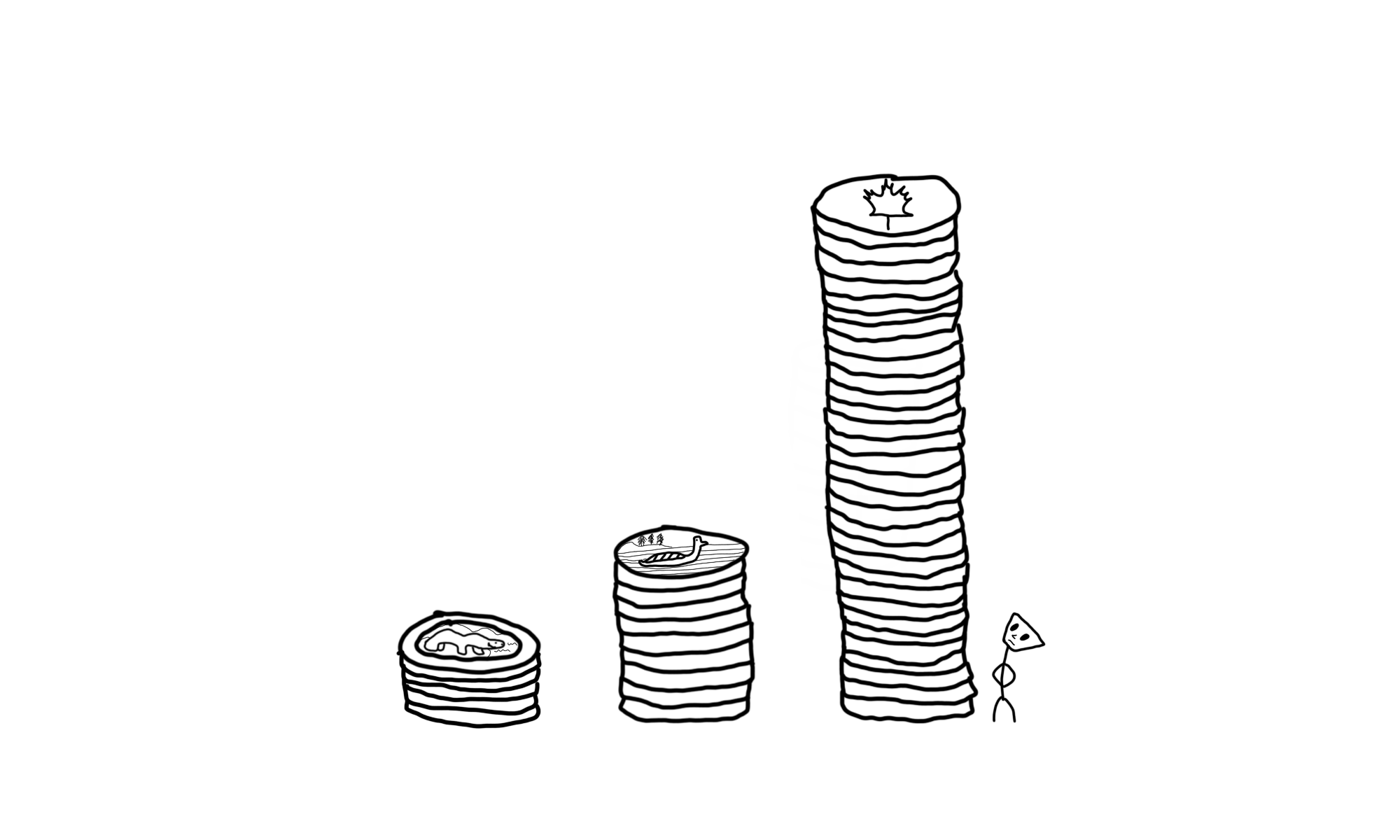Contents:
Interest is a payment made to someone for the use of their money. You pay interest on loans you take out for the use of the lender’s money to buy something like property (mortgage) or education (student). Conversely, banks and other financial institutions will pay you interest on money you “loan” to them – more commonly known as your savings account.
In both cases, the amount of money paid to either party is determined by the interest rate: a percentage of the total amount used to calculate the interest owed to the lender and payable by the borrower. The two types of calculations used are simple and compound with the former paying interest and the latter paying interest on interest on interest.
Simple Interest
As the name suggests, this is a pretty simple way of calculating interest to be paid. You take the principal (initial loan amount, deposit balance, etc.) and multiply it by the interest rate. That’s it. Simple interest rates are generally quoted as an annual rate. With this you can calculate interest to be paid at whatever amount of time is necessary (1 month, 4 years, 3 days, etc.).
2% annual interest rate for:
-----------------------------------------
1 month
2% / 12 = 0.001666667 or 0.1666667%
-----------------------------------------
4 years
2% x 4 = 0.08 or 8%
-----------------------------------------
3 days
2% / 365 = 0.000054795 per day x 3 = 0.000164439 or 0.0164439%
Bonds (from a government or company), Guaranteed Investment Certificates (GIC – known as a Certificate of Deposit in the US), and some loans use the simple interest calculation.
You purchase a 1 year GIC with an interest rate of 1.21% and a value of $3,500.
At the end of that year when you redeem the certificate, you’ll be paid $3,542.35 - your initial $3,500 and $42.35 in interest ($3,500 x 1.21% or $3,500 x 0.0121).
You purchase a 180 day GIC with an annual interest rate of 2.25% and a value of $5,000. At the end of the 180 days you’ll be paid $5,055.48:
2.25% annual rate / 365 days = 0.0061644% per day
0.0061644% per day x 180 days = 1.109589% for the 180 day term
$5,000 x 1.109589% = $55.48 in interest + initial deposit of $5,000 = $5,055.48
Compound Interest
Compound interest gets a little more interesting. For starters, as the name suggests, interest in this calculation compounds (builds on top of or adds to) existing money – interest on interest on principal. It uses the following fancy formula:
A = P x (1+r/n)^nt
(the ^ means exponent; the exponent here is n times t)
Where:
A is the total principal and interest (what we want to find)
P is the principal amount
r is the interest rate (convert to a decimal by dividing it by 100)
n is the rate of compound in days (how often will interest be calculated)
t is the length of the loan/term
If we take the same example used in the simple interest calculation above ($3,500 at a 1.21% rate for 1 year) and compound the interest monthly, it would pay out $3,542.59. The calculation would look something like this:
A = P x (1+r/n)^nt
A = 3500 x (1 + 0.0121 / 12)^12 x 1
A = 3500 x (1 + 0.00100833)^12 x 1
A = 3500 x (1.00100833)^12 x 1
A = 3500 x 1.01216729 x 1
A = 3542.59
Comparison
Comparing the two calculations above with the same inputs (adding the monthly compounding) shows that the compounding method only yields an additional 24 cents over the same time period. Doesn’t seem worthwhile, right? What about if we were to increase the principal to $10,000 and run it over a period of 10 years?
| Calculation Type | Principal | Rate | Period Length | Rate of Compound | Interest Returned |
|---|---|---|---|---|---|
| Simple interest | $10,000 | 1.21% | 10 years | n/a | $1,210 |
| Compound interest | $10,000 | 1.21% | 10 years | Monthly | $1,285.56 |
Still not a huge difference ($75.56 more from compounding) but the power of compounding is on full display. Since long periods of time is where compounding interest really shines, let’s try one more comparison over a period of 35 years:
| Calculation Type | Principal | Rate | Period Length | Rate of Compound | Interest Returned |
|---|---|---|---|---|---|
| Simple interest | $10,000 | 1.21% | 35 years | n/a | $4,235 |
| Compound interest | $10,000 | 1.21% | 35 years | Monthly | $5,269.72 |
Now we’re talking! The compound interest calculation gives us an additional $1,034.72 and 10.35% more return on the initial principal compared to the simple interest calculation. Given the option of the two, which calculation would you rather the bank use when calculating interest owed to you on your savings?
Importance in Personal Finance
The idea of lending one’s money to someone else and receiving compensation for it is fundamental to our financial system. From individuals with savings accounts to organizations with business loans to entire governments and nations indebted to each other.
It should come as no surprise then that compound interest calculations are used in a lot of places – it yields more money than a simple calculation. Time is essential for compound interest to work its magic and below are a few prominent examples that relate to us as individuals.
Savings Accounts
This is the definitive example that we’ve all probably been told about as children, “watch your savings grow with the magic of compound interest”. It’s definitive for a reason: it illustrates how compounding works (your money earns money which earns money), why it’s so great (more money), and it’s relatable (even children can open a savings account).
Mortgages
Mortgages are an example of compound interest working against you since you’re the one who has to pay the interest. They work so well for lenders because of the amortization period (the amount of time that loan payments are spread out over) and compounding the interest owed over that period of time – we’re talking 20-30 years.
This amount of time combined with the large sums of principal typical for mortgages means that even relatively small interest rates (2% or less) when compounded, can yield a huge amount of interest for the lender relative to the loan amount.
To further illustrate the power of compounding over time, compare the 2% and 1.5% mortgages below (both compounding semi-annually with monthly payments):
| Principal Loan Amount | Amortization Period | Interest Rate | Interest Owed (entire amortization period) | Return for Lender on Principal |
|---|---|---|---|---|
| $300,000 | 20 years | 2% | $63,953.64 | 21.32% |
| $300,000 | 30 years | 2% | $98,741.85 | 32.91% |
| - | - | - | - | - |
| $300,000 | 20 years | 1.5% | $47,278.21 | 15.76% |
| $300,000 | 30 years | 1.5% | $72,488.06 | 24.16% |
See how the 1.5% mortgage at 30 years yields more interest than the 2% one at 20 years? Intuitively we might think that the lowest interest rate mortgage is better for us but time and compound interest are powerful things. The takeaway here: there’s a lot more than just the interest rate when it comes to a mortgage – and watch out because compound interest over time is a doozy.
Retirement
Depending on your current age, retirement could be 15, 20, 30, or even 40 years away. That’s a long time for compound interest to work its magic but depending on your risk tolerance and portfolio choices, compound interest may not benefit you directly. You could put your money in a high interest savings account and let compound interest takeover but there are other investments that can earn you more. The idea of compounding your returns will still be used though.
Investing $10,000 in 1 year GICs paying 1.5% for 5 consecutive years (investing only the principal amount each time):
| Year | Investment Amount | Interest Earned | Cumulative Interest Earned |
|---|---|---|---|
| 1 | $10,000 | $150 | $150 |
| 2 | $10,000 | $150 | $300 |
| 3 | $10,000 | $150 | $450 |
| 4 | $10,000 | $150 | $600 |
| 5 | $10,000 | $150 | $750 |
Investing $10,000 in 1 year GICs paying 1.5% for 5 consecutive years (investing principal and interest earned):
| Year | Principal Invested | Interest Earned | Cumulative Interest Earned |
|---|---|---|---|
| 1 | $10,000 | $150 | $150 |
| 2 | $10,150 | $152.25 | $302.25 |
| 3 | $10,302.25 | $154.53 | $456.78 |
| 4 | $10,456.78 | $156.85 | $613.63 |
| 5 | $10,613.63 | $159.20 | $772.83 |
This idea of reinvesting your interest and principal into a new investment is essentially the same as compounding interest, we’re just adding a manual step of reinvesting it – the interest or return is still being compounded with our principal.
We can apply this to just about any investment that yields some kind of interest, dividend, or return on investment like stocks, ETFs, mutual funds, GICs, bonds, or real estate. Some may take longer to liquidate (sell for cash) for reinvestment but still include the principal and earnings.
The key is just to reinvest the returns with the principal to allow compounding to do what it does best.
TL;DR
The simple and compound interest formulas are two ways of calculating money to be paid to a lender for a sum of money that has been borrowed from them. Simple interest is calculated as the principal amount times the annual interest rate times the number of years the interest is to be paid:
interest = principal x annual interest rate x number of years
I = $10,000 x 5% x 3
I = $1,500
--------------------------------------------------
total principal and interest = principal + interest
A = $10,000 + $1,500
A = $11,500
Compound interest takes into account the rate of compounding (annually, semi-annually, monthly, etc.) and the amount of time it compounds for.
total principal and interest = principal x (1 + interest rate / compound rate)^(compound rate x number of years)
A = P x (1+r/n)^nt
A = $10,000 x (1 + 5% / 12 months)^(12 months x 3 years)
A = $10,000 x (1.00416667)^36
A = $10,000 x 1.16147237
A = $11,614.72
Compound interest is a powerful method of accumulating wealth over a long period of time and is fundamental in retirement planning – principal investments or savings generate interest and that interest generates even more interest over time. Use it to your advantage by starting to save as early as possible and reinvesting the returns (interest or dividends) with your principal investment.
Categories
| personal-finance
Tags
| interest
| magic-of-compounding




